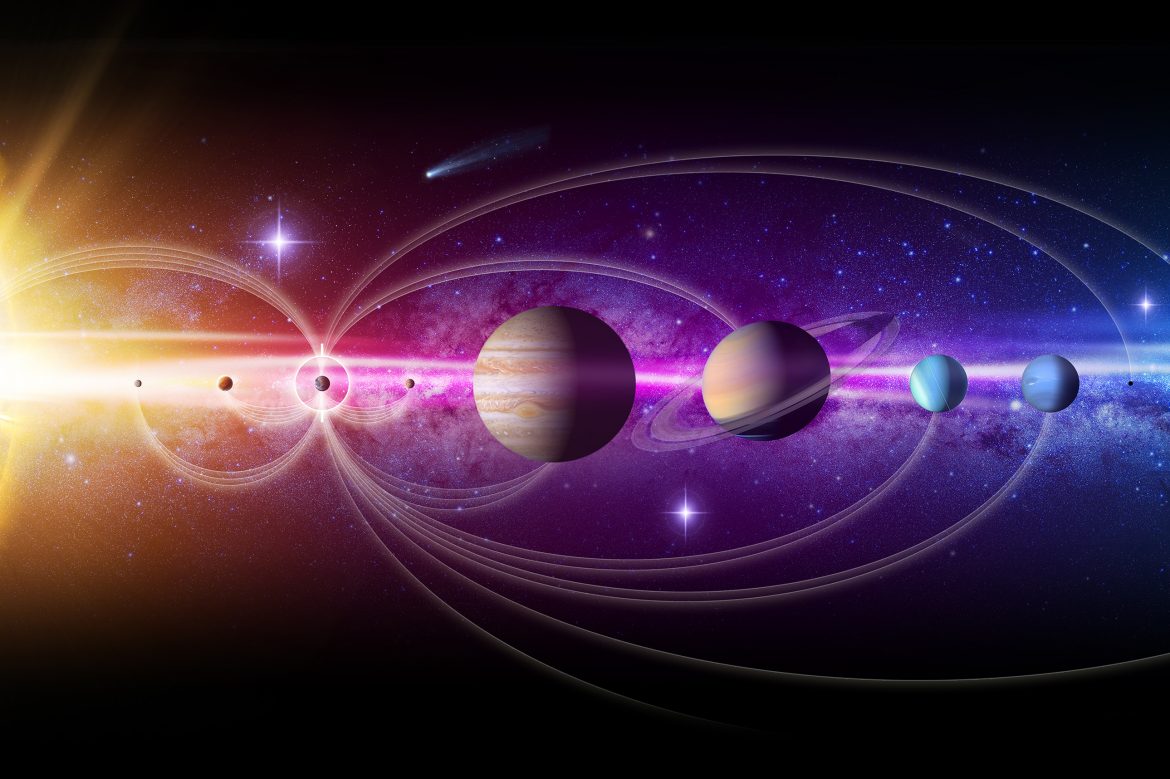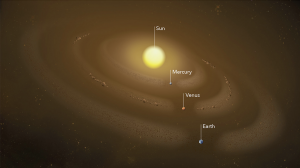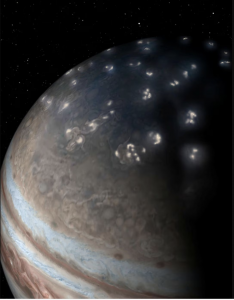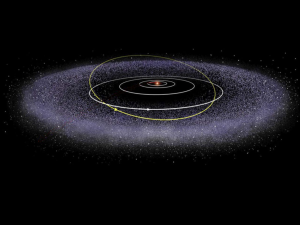
New Discoveries in the Solar System
We have literally fixed our eyes on deep space, until the visible limits of our universe with the help of advanced space and ground telescopes, especially the James Webb Space Telescope, and the newly developed methods to evaluate all the scientific data from the past to the present.
Even though popular science publications make it look like the world of astronomy is mainly interested in exoplanets, distant black holes, and galaxies at the edge of the universe, research on our Solar System continues at full speed.
Let’s take a look at some of the most important recent discoveries on our neighbouring planets and our Solar System.
Mercury
In recent observations, an accompanying ring of dust has been discovered orbiting Mercury, the closest planet to the Sun. Scientists trying to understand the origin of this dust orbiting Mercury report in an article that they cannot fully explain this seemingly impossible phenomenon.
While other rocky planets in the Inner Solar System, including Earth, have similar dust ring companions, such a formation seemed impossible in Mercury’s orbit.
Dust particles traveling towards the Sun from the outer regions of the Solar System, enter into orbital resonance as they pass planets with sufficient gravity on their way and wander around for a while before they continue their course towards the centre. This is how the dust rings around the Earth and Venus were formed. However, since Mercury has a low gravitational pull, like Mars, it was seemingly unlikely to pull such a clump of dust into its orbit.
The most plausible -but yet unproven explanation- is that we are observing fresh dust from asteroids and comets that have recently hit the surface of Mercury before they are drawn to the Sun.

Venus
As we recently explained here, our knowledge about the tectonic structure of our sister planet Venus has changed almost radically.
Although Venus is known to host a number of volcanoes, all of them were thought to be inactive. However, scientists have discovered that the number of these volcanoes is over 85 thousand, almost 50 times the numbers given in past studies. NASA made this discovery with the help of a new map created by using the radar images collected during the Magellan mission in the 1990s.
While data from the mission helps confirm the existence of active volcanoes on the planet, experts think there may be many more volcanoes, even smaller ones, beneath the surface that could be discovered with more modern imaging equipment.
Jupiter
The Juno space probe has been orbiting Jupiter since 2016 to study the giant planet and its moons. Juno keeps sending us breath taking images and information as it continues its extended mission.
Until now, Juno has presented us the geometrically-shaped storms at the gas giant’s poles, the structure of its cloud layers, the planet’s atmospheric properties, its magnetic field, and the similarity of its aurora and lightning formations with the Earth in incredible resolution. Having completed its 51st tour around Jupiter, Juno has impressed the researchers with detailed surface images of Io, Jupiter’s satellite known for its volcanic structure. Volcanic activity on this interesting satellite is better understood by comparing the photographs taken by June during each of its tours around the giant planet.
Io’s high volcanic activity is thought to be the result of Jupiter’s enormous gravitational pull and the passing orbital tugs of the other two moons, Europa and Ganymede. The combined effect of these forces causes enormous tidal forces that cause Io’s surface to swell and squeeze for as much as 100 meters.

Saturn
Scientists have discovered 62 new moons orbiting Saturn. With these latest discoveries, the total number of Saturn’s moons climbed up to 145, surpassing Jupiter’s 95 moons. Using a technique called “shift and stack,” an international research team led by Edward Ashton was able to locate even moons as small as 4.5 kilometres in diameter.
The technique uses a series of sequential images that are shifted at the rate that a moon is moving across the sky, making the object appear brighter when the data is combined. Moons that are too faint to be noticed in single images may therefore be distinguished in the resulting stacked image.
Moons
Saturn and Jupiter are the two largest planets in our Solar System, and they have enough gravity to pull nearby space rocks into their orbits.
Among the many moons of these two gas giants are some of the most fascinating ones in the Solar System, such as Saturn’s Enceladus which is a strong candidate to potentially host extra-terrestrial life, and Jupiter’s Ganymede, the largest moon in our solar system with its own magnetic field.
Re-analysis of data from NASA’s Voyager spacecraft and new computer modelling led NASA scientists to conclude that the four largest moons of Uranus likely contain an oceanic layer between their cores and icy shells. This is the first study to detail the internal structures and the evolution of all of Uranus’ five major moons -Ariel, Umbriel, Titania, Oberon, and Miranda. The study shows that four of these moons harbour oceans that may be tens of kilometres deep.
The outer Solar System is likely to be full of moons with oceans of liquid water, and some may even have geothermal water-rock interactions deep within. On Earth, such regions are known as sources of unusually diverse life, even in the deepest points of the oceans. Widely accepted are the ideas suggesting all life on Earth, including us, may have come from these sources.
In that regard, life could flourish on Europa and Enceladus, in the underground saltwater ocean of Ganymede, below the rivers of methane and ethane on Titan, and perhaps in the salty waters of the deepest craters on the dwarf planets Ceres and Pluto. The researchers speculate that the icy crusts of ocean worlds may even contain liquid water and perhaps pores filled with microbes.
Towards the Outer Boundaries
The Tenth Planet
Efforts continue to find the mysterious 9th planet of our system, once called Planet X as it was supposed to be the 10th planet after Pluto –which was later demoted to the status of dwarf planet.
This planet, assumed to be several times the size of Earth and with a distance from the Sun 20 times that of Neptune, has not been observed in any research so far even though it pops up in all calculations. Another piece of evidence comes from the fact that the orbits of many outer planets, including Uranus and Neptune, are somewhat irregular. This suggests the possible existence of other large objects in the outer Solar System disrupting the orbits of these planets.
Commissioned in 2021, Chile’s Vera C. Rubin Observatory (VRO) began a ten-year survey of space last year, where it is expected to detect thousands of more Kuiper belt objects. Close examination of their orbits can confirm or deny the existence of Planet X, providing clues about its origin and location.
The Mysterious Ring
Astronomers have discovered an entirely new ring system in the Solar System. The ring is about half the size of Pluto and surrounds Quaoar, located beyond Neptune. This is the seventh ring system discovered in the Solar system, and it is so far away from the dwarf planet it surrounds that researchers describe its existence as near impossible.
All six previously known planets with ring systems have rings fairly close to the planet’s surface. This new system surrounding Quaoar really challenges our theories on ring formation.

The Second Kuiper Belt
A presentation by NASA’s New Horizons Science Team strongly suggests that our Solar System actually has a second Kuiper Belt, and the New Horizons spacecraft will visit it in a few years.
Headed towards the depths of the Kuiper Belt, New Horizons continued its observations for more than four years after flying past its second target, the Kuiper Belt Object (KBO) Arrokoth, in 2019.
The spacecraft is currently more than 55 astronomical units away from Earth (AU is equal to the average distance between the Sun and the Earth). When the data it obtained were examined, the orbits of some objects aroused suspicion that they were KBOs belonging to the second Kuiper belt. New Horizons is expected to be in the second belt region in the late 2020s/early 2030s.
REFERENCES
- 1. https://eos.org/articles/mercury-isnt-alone-in-orbit-and-scientists-dont-know-why
- 2. https://iopscience.iop.org/article/10.3847/PSJ/acb52e
- 3. https://www.bbc.co.uk/newsround/64999841
- 4. https://www.science.org/doi/10.1126/science.abm7735
- 5. https://www.space.com/nasa-juno-jupiter-io-volcanic-moon-images
- 6. https://www.reuters.com/science/nasa-spacecraft-documents-how-jupiters-lightning-resembles-earths-2023-05-24/
- 7. https://www.jpl.nasa.gov/news/new-study-of-uranus-large-moons-shows-4-may-hold-water
- 8. https://nasawatch.com/space-science-news/there-may-be-a-second-kuiper-belt-and-new-horizons-is-headed-there/
- 9. https://www.livescience.com/impossible-new-ring-system-discovered-at-the-edge-of-the-solar-system-and-scientists-are-baffled
